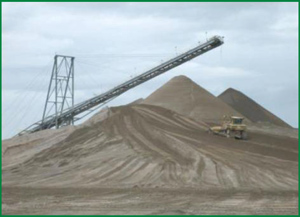ASSESSING AND MITIGATING CARBON RISK

Chavapong Prateep Na Thalang/iStock
Deadlines for important decarbonization commitments are looming closer for many miners. An article in the latest Energy and Mines discusses how mining companies can analyze their carbon exposure and mitigate carbon risk.
Carbon risk modelling
The first trick is determining a mining company’s real-world carbon emissions, both upstream and downstream of production, as well directly from operations. As the article suggests, this is not an exact science. In a nutshell, there are two basic approaches — analyzing exposure in terms of absolute emissions (the total amount of GHG emissions across operations) or analyzing emissions intensity (the amount of emissions per unit of output, such as tons of metal produced). Jun Song, Vice President, Global Carbon, Macquarie Group tells E&M that there is no clear answer as to which option miners should choose.
“Absolute emissions and emissions intensity present two different metrics in terms of tracking a net zero commitment which might be in line with whatever ‘best practice’ governs how miners would like to meet their net zero targets on a voluntary basis,” says Song. He recognizes that the biggest challenge is around calculating scope three emissions (those downstream of mine operations) and advises miners to seek help where needed. “There’s a lot of ecosystem services that exist out there to help miners to calculate the overall carbon footprint of their operations from source all the way to the end customer,” he says.
Unclear standards
The next step in a mine’s decarbonization journey is to choose a standard to align with, whether it be the GHG Protocol, the Voluntary Carbon Markets Integrity Initiative (VCMI), the Science-Based Targets Initiative (SBTI), or another recognized initiative. Soon says, “On the voluntary side, the sheer number of initiatives, councils, science-based targets and guidelines has potentially created some confusion among participants. There’s still effectively a lack of consensus as to what is accepted.” E&M expects that as the carbon market matures, these initiatives should converge into generally accepted best practices, but for now, “keeping a finger on the pulse of new developments is important.”
On the compliance side (for large emitters subject to their jurisdiction’s carbon regulation), the rules to follow are clearer. Says Soon, “it’s very clear what sort of thresholds are required, what scope is required, and therefore the challenge there may be around not having the experience, systems or dedicated team to monitor and make the calculation.” Here again he suggests miners seek help from advisers such as the Big Four and other environmental consultants.
Carbon offsets can help
Once miners have clearly mapped and understood their carbon footprint, they can put in place a reduction and mitigation strategy to lower their carbon risk. Carbon offsets, which companies can purchase from sustainable projects to compensate for hard-to-abate emissions, have a role to play.
Per E&M, “Recent standards and regulations make it clear just how much decarbonization can be achieved through offsets.” However, in many regulatory schemes, emitters are only allowed to use offsets to meet part of their decarbonization targets, or they are required to justify “why onsite abatement hasn’t been undertaken” in order to continue using offsets.
The bottom line, says Soon, is that carbon credits should only be used as part of a holistic carbon mitigation strategy. “Miners who do not have any direct activities to reduce their carbon footprint and solely rely on offsets are at risk of being criticized and potentially associated with greenwashing. The key is to avoid emissions wherever possible, reduce the emission intensity of operations, and finally use offsets to bridge the gap between reductions and net zero targets.”
For more on carbon credits, read the full Energy and Mines article here.
A ROUND-THE-CLOCK CLEAN ALTERNATIVE TO FOSSIL FUELS
An array of 247Solar HeatStorE long-duration thermal batteries
Achieving high levels of renewable energy is particularly challenging for off-grid mines in remote locations because intermittent PV or wind with costly batteries still require dirty, expensive diesel for backup. Many mines also require high-grade heat for on-site processing and other uses. 247Solar offers the only renewable energy technologies that:
- Integrate seamlessly with PV or wind to provide 24/7 dispatchable baseload power
- Provide industrial grade heat up to 970 ℃ (1800 ℉) for ore processing, steam generation and other applications
- Provide their own backup by burning almost any locally available fuel to produce power even when storage is depleted, eliminating gensets and reducing fuel costs up to 80%
Get in touch to learn more
CHINA PUTS EXPORT CONTROLS ON GALLIUM, GERMANIUM PRODUCTS

Reuters
China has announced new restrictions on exports of eight gallium and six germanium products widely used in semiconductors, electric vehicles and other high-tech industries. The move has the potential to cause disruption to global supply chains, but may also accelerate efforts elsewhere to develop local resources.
According to Reuters, analysts see the move as a response to escalating efforts by the United States and Western allies to curb China’s technological advances. Some in the metals industry told Reuters they feared China could follow with new restrictions on rare earth exports. China is the world’s biggest producer of rare earths, a group of metals used in EVs and military equipment. China also produces most of the world’s gallium and germanium.
In a sign of the potential for new production outside China, Reuters reports that Dutch metals processor Nyrstar said it would look at germanium and gallium projects in Australia, Europe and the United States. Reuters quotes Constantine Karayannopoulos, CEO of Canada’s Neo Performance Materials, as saying it would be difficult to meet market demand without Chinese gallium supply, though work-arounds could be possible with the right industrial public policy incentives. “[This measure] could give very significant impetus to North American and European governments – along with producers and consumers of high-purity gallium outside of China – to consider more seriously what it takes to establish supply chain optionality.”
Read more here.
NORWAY FINDS HUGE STRATEGIC MINERAL DEPOSITS
 The Economist reports that Norge Mining, an Anglo-Norwegian company, has found massive deposits of ultra-pure phosphate rock, vanadium and titanium in south-western Norway. Titanium is used to build airplanes, vanadium is used in steelmaking and for high-tech batteries, and phosphates are used in fertilizer and to obtain phosphorus for computer chips and solar panels.
The Economist reports that Norge Mining, an Anglo-Norwegian company, has found massive deposits of ultra-pure phosphate rock, vanadium and titanium in south-western Norway. Titanium is used to build airplanes, vanadium is used in steelmaking and for high-tech batteries, and phosphates are used in fertilizer and to obtain phosphorus for computer chips and solar panels.
The economist writes, “For all of these minerals, Europe and America depend on worryingly unreliable suppliers. Airbus buys half its titanium from a Russian manufacturer. Boeing’s Japanese titanium suppliers import ore from Africa, where it may be under Chinese control. China, Russia, South Africa and Brazil dominate vanadium production; America imports nearly all of the ore it uses. Phosphates and phosphorus are newly relevant as Europe and America worry about food security and try to relaunch their chip and solar industries.”
Together with Sweden’s recent discovery of rare-earth metals in its far north, this find should help the West further reduce its dependence on Russia and China for strategic raw materials.
FOLLOW & JOIN 247Solar
LinkedIn US, LinkedinEU, Twitter, YouTube
Contact: info@247solar.com
